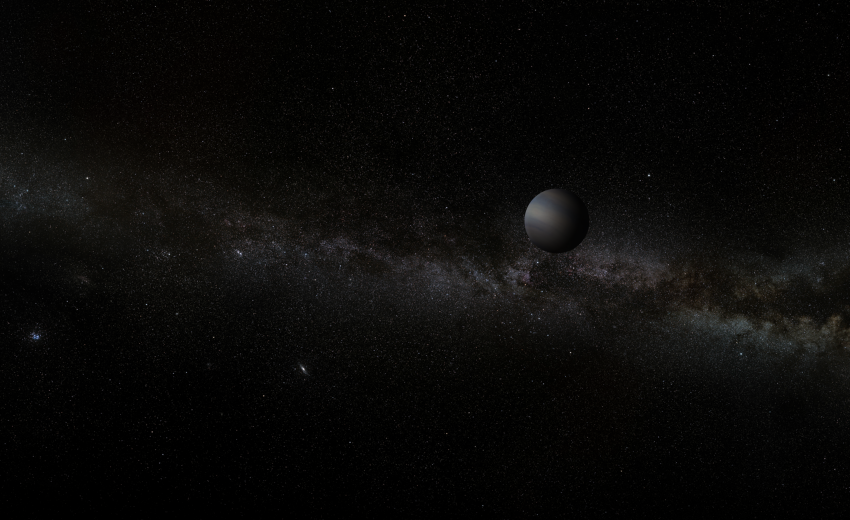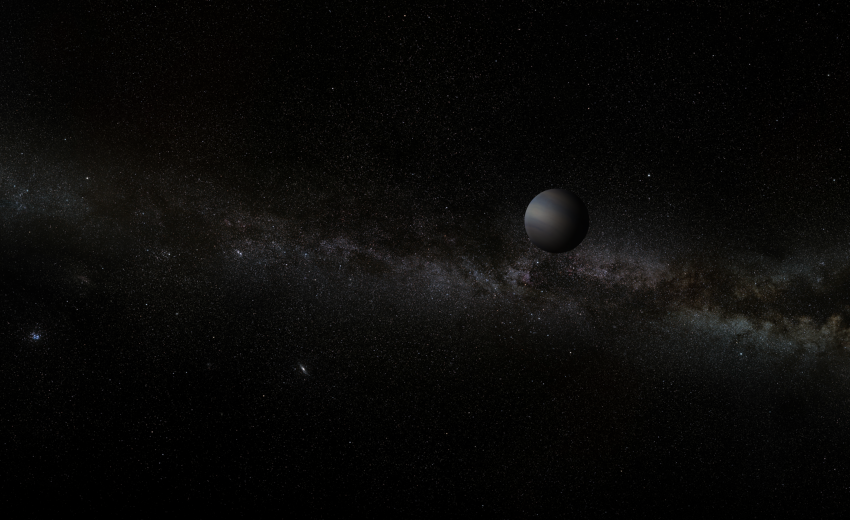Tantalising evidence has been uncovered for a mysterious population of “free-floating” planets, planets that may be alone in deep space, unbound to any host star. The results include four new discoveries that are consistent with planets of similar masses to Earth, published today in Monthly Notices of the Royal Astronomical Society.
The study, led by Iain McDonald of the University of Manchester, UK, (now based at the Open University, UK) used data obtained in 2016 during the K2 mission phase of NASA’s Kepler Space Telescope. During this two-month campaign, Kepler monitored a crowded field of millions of stars near the centre of our Galaxy every 30 minutes in order to find rare gravitational microlensing events.
The study team found 27 short-duration candidate microlensing signals that varied over timescales of between an hour and 10 days. Many of these had been previously seen in data obtained simultaneously from the ground. However, the four shortest events are new discoveries that are consistent with planets of similar masses to Earth.
These new events do not show an accompanying longer signal that might be expected from a host star, suggesting that these new events may be free-floating planets. Such planets may perhaps have originally formed around a host star before being ejected by the gravitational tug of other, heavier planets in the system.
Predicted by Albert Einstein 85 years ago as a consequence of his General Theory of Relativity, microlensing describes how the light from a background star can be temporarily magnified by the presence of other stars in the foreground. This produces a short burst in brightness that can last from hours to a few days. Roughly one out of every million stars in our Galaxy is visibly affected by microlensing at any given time, but only a few percent of these are expected to be caused by planets.
Kepler was not designed to find planets using microlensing, nor to study the extremely dense star fields of the inner Galaxy. This meant that new data reduction techniques had to be developed to look for signals within the Kepler dataset.
Iain notes: “These signals are extremely difficult to find. Our observations pointed an elderly, ailing telescope with blurred vision at one the most densely crowded parts of the sky, where there are already thousands of bright stars that vary in brightness, and thousands of asteroids that skim across our field. From that cacophony, we try to extract tiny, characteristic brightenings caused by planets, and we only have one chance to see a signal before it’s gone. It’s about as easy as looking for the single blink of a firefly in the middle of a motorway, using only a handheld phone.”
Co-author Eamonn Kerins of the University of Manchester also comments, "Kepler has achieved what it was never designed to do, in providing further tentative evidence for the existence of a population of Earth-mass, free-floating planets. Now it passes the baton on to other missions that will be designed to find such signals, signals so elusive that Einstein himself thought that they were unlikely ever to be observed. I am very excited that the upcoming ESA Euclid mission could also join this effort as an additional science activity to its main mission."
Confirming the existence and nature of free-floating planets will be a major focus for upcoming missions such as the NASA Nancy Grace Roman Space Telescope, and possibly the ESA Euclid mission, both of which will be optimised to look for microlensing signals.
Media contacts
Dr Robert Massey
Royal Astronomical Society
United Kingdom
Tel: +44 (0)20 7292 3979
Mob: +44 (0)7802 877 699
press@ras.ac.uk
Dr Morgan Hollis
Royal Astronomical Society
United Kingdom
Mob: +44 (0)7802 877 700
press@ras.ac.uk
Science contacts
Dr Eamonn Kerins
University of Manchester
Eamonn.Kerins@manchester.ac.uk
Dr Iain McDonald
The Open University
iain.mcdonald@open.ac.uk
Images and captions
A simulation of the gravitational microlensing effect induced by a foreground isolated planetary body on the light from a background star located towards the centre of the Milky Way galaxy.
Credit: David Specht / Eamonn Kerins / University of Manchester
Further information
The new work appears in: “Kepler K2 Campaign 9: I. Candidate short-duration events from the first space-based survey for planetary microlensing”, I. McDonald, E. Kerins, R. Poleski et al., Monthly Notices of the Royal Astronomical Society (2021), in press (DOI: 10.1093/mnras/stab1377).
Notes for editors
The Royal Astronomical Society (RAS), founded in 1820, encourages and promotes the study of astronomy, solar-system science, geophysics and closely related branches of science. The RAS organises scientific meetings, publishes international research and review journals, recognises outstanding achievements by the award of medals and prizes, maintains an extensive library, supports education through grants and outreach activities and represents UK astronomy nationally and internationally. Its more than 4,000 members (Fellows), a third based overseas, include scientific researchers in universities, observatories and laboratories as well as historians of astronomy and others.
The RAS accepts papers for its journals based on the principle of peer review, in which fellow experts on the editorial boards accept the paper as worth considering. The Society issues press releases based on a similar principle, but the organisations and scientists concerned have overall responsibility for their content.
Follow the RAS on Twitter, Facebook, Instagram and YouTube
Download the RAS Podcast from Audioboom



